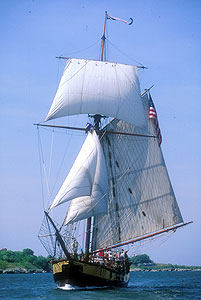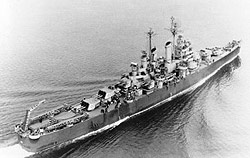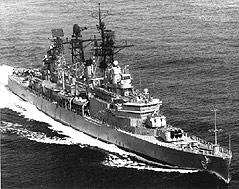|
|
Facts
Commisioned: 1776
Length: 110'
Armament: 12- 4 pounders
Crew: 90
Vessels captured/sank: 40
|
|
|
|
|
|
|
|
|
|
|
History of USS Providence
The capital of Rhode Island, in turn named in thanksgiving for God's guidance and care.
|
|
|
|
 |
|
Sloop Providence - 1776
|
In early 1775, British men-of-war, especially His Majesty's Frigate Rose, preyed on Rhode Island shipping and harassed the colony's coast. The Rhode Island General Assembly ordered the Committee of Safety to fit out two ships to defend the colony's shipping and appointed a committee of three to obtain the vessels.
The committee chartered sloop Katy from John Brown of Providence and sloop Washington. Soon after, Katy was purchased by Rhode Island, and late in November, she sailed for Philadelphia where she was taken into Continental service and renamed Providence. Captain John Hazard was placed in command of Providence, and joined a squadron formed by Congress under the command of "Commander in Chief of the Fleet of the United Colonies," Esek Hopkins.
On 10 May 1776, John Paul Jones assumed command of Providence with a temporary rank of Captain. Jones sailed escorting Fly to Fisher's Island at the entrance to Long Island Sound, and while enroute, he saved a brigantine bringing munitions from Hispanola from British frigate H.M.S. Cerberus. Providence then escorted a convoy to Philadelphia arriving 1 August. A week later, Jones received his permanent commission as Captain.
Providence departed the Delaware Capes, and in a few days took brigantine Britannia. On 1 September, daring seamanship enabled Jones to escape from British frigate Solebay. Two days later Providence captured Sea Nymph, carrying sugar, rum, ginger, and oil. On the 6th Providence caught brigantine Favourite carrying sugar from Anitgua to Liverpool, but H.M.S. Galatea recaptured the prize before she could reach an American port.
Turning north, Jones headed for Nova Scotia, and on 20 September escaped another frigate, burned a British fishing schooner, sank a second, and captured a third besides a shallop which he used as a tender. Moving to Ile Madame, Providence took several more prizes fishing there. One more prize, whaler Portland surrendered to Providence before she returned to Narragansett Bay 8 October.
The British seized Narragansett Bay in December 1776 and Providence with other American vessels retired up the Providence River. In February 1777, under Lt. Jonathan Pitcher, Providence ran the British blockade; and after putting into New Bedford, cruised to Cape Breton, where she captured a transport brig loaded with stores and carrying two officers and 25 men of the British Army.
Under command of Capt. J.P. Rathbun, Providence made two cruises on the coast and about mid-January 1778, sailed from Georgetown, N.C., bound for New Providence in the Bahamas. On 27 January she spiked the guns of the fort at Nassau, taking military stores including 1,600 pounds of powder, and released 30 American prisoners. She also made prize of a 16-gun British ship and recaptured five other vessels which had been brought in by the British.
During the early part of April 1779 Providence was ordered to make a short cruise in Massachusetts Bay and along the coast of Maine. She later sailed south of Cape Cod and on 7 May, captured H.M.S. Brig Diligent, 12 guns, off Sandy Hook. She fired two broadsides and a volley of muskets during the engagement and Diligent, with mast rigging and hull cut to pieces, was forced to surrender.
She then was assigned to Commodore Saltonstall's squadron which departed Boston 19 July 1779 and entered Penobscot Bay 25 July. She was destroyed by her crew, with other American vessels in the Penobscot River, 14 August 1779, to prevent her falling into the hands of the British.
(Frigate: tonnage 632; length 126'6.5"; beam 33'8"; depth 10'5"; armament 28 guns)
The second Providence, a 28-gun frigate, built by Silvester Bowes at Providence, R.I., by order of the Continental Congress, was launched in May 1776.
After being blockaded in the Providence River for more than a year, the new frigate, under the command of Captain Abraham Whipple, ran the British blockade on the night of 30 April 1778, returning the heavy fire of the British ship Lark and damaging that vessel, then fighting a running battle with another vessel of the British blockading force. She sailed directly for France, arriving at Paimboeuf 30 May to procure guns and supplies for Continental Navy vessels under construction. She sailed from Plaimboeuf 8 August and six days later, joined frigate Boston at Brest, France. The two ships sailed back to America 22 August. They took 3 prizes on the return voyage and Providence arrived Portsmouth, N.H., 15 October.
Transferred to Boston to seek a crew, Providence sailed from Boston 18 June 1779 as flagship of Commodore Abraham Whipple, cruising eastward in company with Ranger and Queen of France. In the early morning of mid-July, the squadron was in a dense fog off the banks of Newfoundland and fell in with a Jamaican fleet of some 150 sails. The vessels remained with the enemy fleet all day without causing alarm. They took 11 prizes, many by quietly sending boats to take possession. The squadron slipped away with their prizes during the night. They sent 8 of the prizes, valued together with their cargo at over a million dollars, into Boston and Cape Ann. The Squadron returned to Boston and 23 November sailed from Nantasket Roads, first cruising eastward of Bermuda, arriving at Charleston 23 December to defend the city.
Providence, with other ships of Commodore Whipple's Squadron remained for the defense of Charleston and was one of the ships taken by British when that city fell, 12 May 1780. She subsequently served in the British Navy until sold in March 1783.
III
(Gundalow: length 53'4"; beam 15'6"; depth 3'10"; complement 45; armament 1 12-pounder; 29-pounders; 8 swivels)
During the Revolutionary War, Providence, a gundalow, was built at Skenesboro, N.Y., on Lake Champlain by the Continental Army for Brigadier-General Benedict Arnold's fleet on Lake Champlain in 1776.
Under the command of Captain Simonds, an Army officer, she participated in the engagement between Arnold's fleet and a British squadron at Valcour Island on 11 October 1776. After the battle, their ammunition nearly exhausted, the Americans retreated towards Crown Point, with the enemy in pursuit and the next morning (the 12th) Providence, being badly damaged, was sunk at Schuyler's Island by her own crew to prevent capture. This tactical defeat was a strategic victory for the Americans since Arnold's little fleet enabled the rebelling colonists to prepare for the renewed British onslaught the following summer which ended in Burgoyne's defeat at Saratoga.
IV
Light Cruiser, CL-82: displacement 13,755 (full load); length 610' 1"; beam 66' 4"; draft 25'; speed 32 knots; complement 992; armament 12 6", 12 5", 28 40 millimeter, 10 20 millimeter, 2 catapults; class: Cleveland)
 Providence (CL-82) was laid
down 27 July 1943 by Bethlehem Steel Co., Quincy, Mass.; launched 28 December 1944; sponsored by Mrs. Mary Roberts; and commissioned 15 May 1945, Capt. W. B. Jackson in command. Providence (CL-82) was laid
down 27 July 1943 by Bethlehem Steel Co., Quincy, Mass.; launched 28 December 1944; sponsored by Mrs. Mary Roberts; and commissioned 15 May 1945, Capt. W. B. Jackson in command.
Departing Boston 13 June 1945, Providence (CL-82) completed shakedown out of Guantanamo Bay, Cuba. Upon arrival at Newport, R.I., 4 September, she trained prospective cruiser and carrier crews until 6 October.
Departing Boston in November, she visited Piraeus, Greece in December, Istanbul with Missouri (BB-63) 5 to 9 April 1946, and Alexandria, Egypt in May. Leaving the Mediterranean 16 June, she arrived at Philadelphia on the 25th. Following departure from the Delaware Capes in October and training out of Guantanamo Bay and Norfolk, Va., she left Hampton Roads for the Mediterranean 3 February 1947. After exercises and port visits in the Mediterranean she departed Athens, Greece, in May, and arrived at Boston later that month.
Departing Newport, R.I., in November, she operated in the Mediterranean from 20 November 1947 to 2 March 1948, visiting Naples in December, Taranto in January, and Trieste and Venice in February, returning to Newport in March. Sailing from Newport in September 1948, she served the 6th Fleet in the Mediterranean from 23 September 1948 to 14 January 1949, visiting Thessalonika in October, Marseilles in November, Trieste and Venice in December, and Oran in January, returning to Newport later in January. She decommissioned at Boston 14 June 1949, and entered the Atlantic Reserve Fleet.
 Reclassified CLG-6 on 23 May 1957, Providence commenced conversion to a guided missile light cruiser at Boston in June 1957. Provided with modern missiles, command ship facilities and a nuclear weapons capability, she recommissioned 17 September 1959, Capt. Kenneth L. Veth in command. Following shakedown out of Guantanamo Bay, she arrived at her new home port of Long Beach, Calif., 29 July 1960. After a six month tour of duty with the 7th Fleet, she returned to Long Beach 31 March 1961. Reclassified CLG-6 on 23 May 1957, Providence commenced conversion to a guided missile light cruiser at Boston in June 1957. Provided with modern missiles, command ship facilities and a nuclear weapons capability, she recommissioned 17 September 1959, Capt. Kenneth L. Veth in command. Following shakedown out of Guantanamo Bay, she arrived at her new home port of Long Beach, Calif., 29 July 1960. After a six month tour of duty with the 7th Fleet, she returned to Long Beach 31 March 1961.
Following exercises off the west coast, she arrived at Yokosuka, Japan, in May 1962, and relieved Oklahoma City (CLG-5) as flagship of the 7th Fleet. During 1962 and 1963, she participated in 7th Fleet exercises. During a three day visit to Saigon in January 1964, she hosted South Vietnamese and American dignitaries, and delivered more than 38 tons of Project Handclasp materials to local humanitarian organizations. Departing Yokosuka in July 1964, she returned to Long Beach in August. In October 1964, she began exercises in the Eastern Pacific. During January to June 1965, she received modern communications equipment. Spending the remainder of 1965 off the west coast with the 1st Fleet, she participated in exercises and visited various west coast ports.
Deployed to WestPac 12 November 1966, she again relieved Oklahoma City as flagship of the 7th Fleet on 1 December 1966 at Yokosuka, Japan. She contributed to a major bombardment of enemy positions in Vietnam 1 April 1967. She dueled with an enemy shore battery off the DMZ on 25 May. In July, she provided gunfire support for amphibious operations. She bombarded enemy storage areas south of Da Nang 10 October.
During 1968, she provided gunfire support off Vietnam during each month except June and December. In February 1968, during the enemy's Tet offensive, gunfire from Providence effected an important breach in the wall of an enemy strongpoint at Hue. During 1969 she operated with the 1st Fleet off the west coast. Into 1970 she remained active with the Pacific Fleet.
8 August 2001
from the Dictionary of American Naval Fighting Ships
|
|
|
|
|
|
|
|

